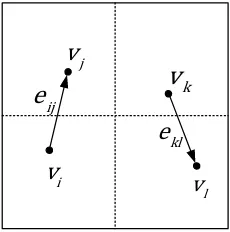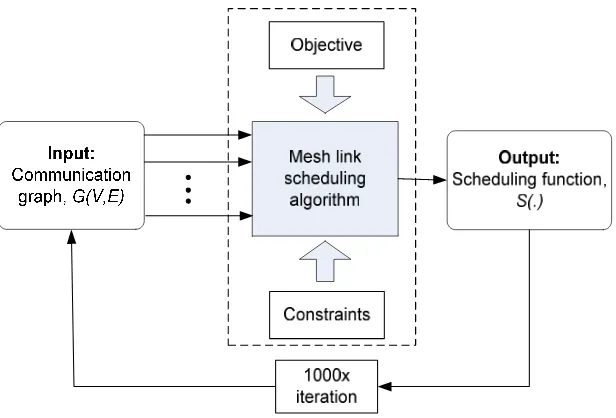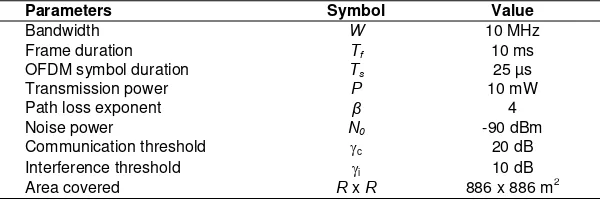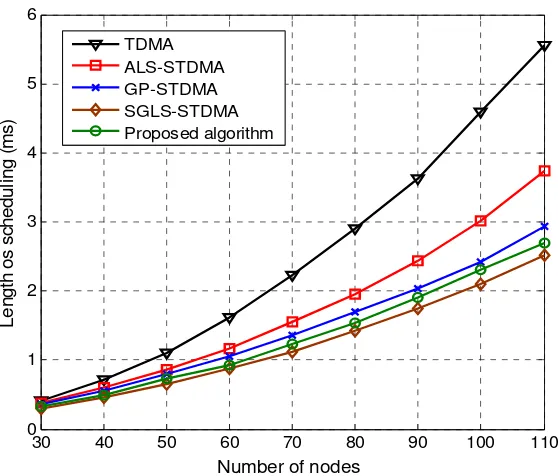DOI: 10.12928/TELKOMNIKA.v13i1.790 202
Modified Greedy Physical Link Scheduling Algorithm
for Improving Wireless Mesh Network Performance
Nachwan Mufti Adriansyah*, Muhamad Asvial, Bagio Budiardjo
Electrical Engineering Department, Universitas Indonesia Kampus Baru UI Depok 16424, Indonesia *Corresponding author, e-mail: [email protected]
Abstract
The algorithm to allocate mesh active link to radio resource timeslot in wireless mesh network (WMN) is investigated. This paper proposes the novel method to allocate multiple links in one timeslot for improving the wireless mesh network throughput via spatial time division multiple access (STDMA) protocol. The throughput improvement is obtained by modifying greedy based algorithm that is widely known as a low complexity algorithm. We propose and investigate new parameters in the greedy based algorithm that can be used as scheduling control parameters, i.e. interference weight, scheduling weight, and the sum of link’s degree. Simulation results indicate that this approximation increases network performance in throughput and length of scheduling performance closed to the upper bound performance that is achieved by the algorithm that uses the physical interference model.
Keywords: WMN, STDMA, greedy algorithm, link scheduling
1. Introduction
The mesh or multi-hop topology curently is seen as a strong candidate topology to improve wireless network capability and has a number of advantages and used for many applications [1]–[3]. Recently, wireless mesh network has emerged as an interesting research area and gaining attention from researcher to improve this tipical network in different aspects [1] [4][5]. Specifically to improve radio resource efficiency utilization in the multi-hop wireless mesh network (WMN), Nelson and Kleinrock [6] introduce the spatial time division multiple access (STDMA). The STDMA protocol access enables to allocate multiple links or node transmissions in one timeslot as long as those concurrent transmissions do not degrade signal quality. The mesh link scheduling problem is proved as NP hard problem [7] and there are many algorithms developed in STDMA protocol access [7]–[11]. The crucial objective of the mesh link scheduling optimization problem is to maximize the number of links that is allocated in timeslot resources.
Gupta and Kumar [12] introduce two interference models for the link scheduling capacity evaluation, i.e. protocol and physical interference model. Due to its simplicity, the protocol interference model is widely used by researchers to develop the STDMA link scheduling algorithms [13]–[15]. On the otherhand, the algorithms that are developed in physical interference model is proven to have better performance than the other algorithms with comparable developed in protocol interference model [16],[17], but always in higher computational complexity. For this reason, we need to design mesh link scheduling algorithm in physical interference model with low computational complexity and a good performance.
Greedy based algorithm is known to have a low complexity algorithm for resource allocation. Brar et al introduce greedy physical algorithm [18] as STDMA algorithm in physical interference model [19],[20]. The best performance of physical STDMA link scheduling given by Gore et al [10], namely signal to interference ratio graph link schedule (SGLS) algorithm. SGLS algorithm provide the best performance of mesh link scheduling by iteratively check SINR for all links that scheduled in the same timeslot, so that this algorithm have highest network throughput known so far. The time computational complexity of SGLS algorithm is reported .
algorithm [18] and closed to to the best result that is given by physical interference based scheduling performance [21].
The problem formulation of STDMA link scheduling is described as follows. The input of link scheduling algorithm is a communication graph , , i.e. the mesh topology that consists of all the nodes and the active communication links with signal to noise ratio (SNR) above the minimum threshold, . The set of nodes is represented by , , … , and the set of active communication links is represented by , , … , . The link scheduling algorithms intend to allocate the different mesh active communication links , that is geographically separated, to the certain timeslot. So that the signal to interference and noise ratio (SINR) of all links in this timeslot should satisfy the minimum threshold . If link is allocated in the same timeslot with link , this condition must always satisfy of physical interference model requirement [12],
The output of the mesh link scheduling algorithm is the mesh link schedule .
, , , … , , where is the number of time slots to complete the scheduling task. In
wireless mesh network link scheduling optimization problem, we have an objective function to maximize network throughput (2). The constraints are: all links are scheduled at least one along the length of scheduling (3), each node cannot transmit and receive in one time slot (4), a node can transmit/receive only to/from one other node in one time slot (5-6), and all transmissions must satisfy physical interference model requirement (7).
The integer linear programming (ILP) representation of STDMA link scheduling problem as follows:
2. The Proposed Algorithm
The basic of the greedy physical algorithm for STDMA protocol access (GP-STDMA) is introduced by Brar et al [18]. The principle of this algorithm is to perform scheduling by interference evaluation for each link. To analyze interference, the GP-STDMA algorithm transforms the communication graph into a conflict graph. The link with the largest number of interference will be scheduled first after link’s interference sorting. The link’s interference in communication graph is represented by degree of node in the conflict graph. Greedy algorithm is known to provide low computational complexity, but not provide optimal performance. On the otherhand, Gore et al [10] introduce SGLS-STDMA algorithm that is provide the near optimal performance but higher in complexity. In this paper, we should achieve network performance near to the performance achieved by [10] but with lower algorithm complexity.
In this section, the improved greedy physical spatial time division multiple access is proposed. In contrast with the basic greedy physical algorithm in [18], the proposed algorithm do not perform the graph transformation. The conflict free scheduling is guaranteed and decided based on three interference parameters: the block partition evaluation, the sum of link’s degree evaluation, and the scheduling weight evaluation. After that, the physical interference model is used to guarantee SINR requirement.
From the communication graph , , the set of active communication links are evaluated so that the candidate of links that can be allocated in one timeslot can be defined. The area of the mesh network is divided to some blocks partition, where this partition method is used previously in [22][23]. The number of block that is used in this paper is
partition blocks. Normatively, the link can be allocated in the same timeslot with link if satisfy requirements as follows (Fig.1):
- Node in different block partition with its interference nodes (node , and node )
Figure 1. Mesh active link in four block partition
For interference quantification, the sum of link’s degree and the interference weight are defined. The sum of link’s degree of link is defined as
where is degree of node . The links with higher means that those links on dense network topology in the evaluated area because this link is connected with many of the links. So that, the links with higher is given priority scheduling firstly in a greedy way.
The other quantification of interference is represented by the interference weight that is derived from the distance of two links. For link dan link , the interference weight is defined as:
max , (8)
So that, the scheduling weight can be defined as follows,
The scheduling weight ′ , is used as the interference parameter where higher ′ means longer distance of two links, so that the link with high ′ have a high probability to schedule. To give high link scheduling efficiency, scheduling starts from link with minimum scheduling weight to maximum value.
The final evaluation is to guarantee SINR of links that are allocated in particular timeslot should be satisfying minimum threshold of SINR. Consider to node receiver for SINR guarantee with physical interference model, Equation 10 can be derived from Equation 7.
(10)
where the total interference experienced in node sourced from a number of node represented as as follows,
∑ (11)
So that, with substitute (10) to (11) can be found the requirement of link allocation to satisfy physical interference constrain in Equation 7, as follows:
∑ (12)
The pseudocode of the proposed algorithm is described below,
Proposed Algorithm: Input:
, → , , … , , Output:
Transmission schedule , , … , Steps of algorithm:
1. Sort , , … , in decreasing order based on interference degree 2. Candidate links generation with block partition criteria evaluation
3. Initialization: ;
4. ∅
5. Select one link from , i.e. ; allocate in ; ← 6. Sort in increasing order ′
7. Select one candidate e.g. to be evaluated with the Physical Interference Model. If , allocate
to , then ⋃
8. Return to following candidates, repeat step 7 to 8 until all candidates for are evaluated 9. , repeat step 5 to 9 where until link scheduling completed 10. Compute link scheduling performance
The asymptotic time complexity analysis is used to analyze the computational complexity parameter in the certain time constraint. In the proposed algorithm, computational complexity can be analyzed from each process in the algorithm.
The set of active links is sorted based on the sum of the link’s degree requires
O e log e operations. The sorting result is defined as as the input of the scheduling
algorithm. For each link element in , block partition evaluation is performed in order to generate candidate links that can be allocated concurrently with link . The block partition evaluation requires e operations. The calculation of scheduling weight takes e operations. So that, the input of link scheduling generation requires e log e e e e operations.
weight to be SINR evaluated requires |e | log|e | time, where |e | |e| and in the worst case
|e | e.
The physical interference evaluation for m candidate links require complexity m where m is the number of links that is allocated to the same timeslot and m |e |. This process is repeated until all links have been completely assigned. So that, the complexity of this process is . .
The time complexity in one cycle algorithm is | | | | log| | . , where | |~ . This process repeated for all links in . So that, the total time complexity is
log . Furthermore, in the worst case of the total computational complexity is approximated
to e e e log e m ≅ e log e ≅ O e .
3. Research Method
The model of link scheduling process depicted in Figure 2. The purpose link scheduling in the wireless mesh networks is to maximize the number of links that are allocated in a timeslot as a radio resource.
Figure 2. Mesh link scheduling simulation modeling
In this paper, the wireless mesh network performance measured in length of scheduling and network throughput.The length of scheduling is defined as multiplication of the number of timeslot that is required to complete scheduling ( ), with the timeslot duration ( ), as follows:
(13)If is the number of links that schedule concurrently in timeslot , then link schedule in timeslot represented by , , … , . Link schedule repeats periodically with the fixed pattern along the network operation, so that a pair of transmitter-receiver that transmits in timeslot will communicate again in timeslot , … and so on.
Using the Shannon’s formula [24], the achievable data rate for link ∈ , i.e. has the upper bound value as:
So that, the amount of bits transferred in one timeslot is , where is timeslot duration and is the bandwidth allocation for wireless mesh network. Such that, average throughput for all transmission links as follows:
∑ ∑ ∑ ∑ , (bps) (15)
where is the number of active communication links and , is the upper bound of data rate timeslot- and is the number of links transmitted concurrently in timeslot- .
The mesh link scheduling performance is obtained by Monte-Carlo simulation method. The stationary node positions are randomly generated in a square area for each iteration and then the process to evaluate the current mesh topology is started. For each topology in one iteration, all of active links are scheduled based on the algorithm which is evaluated. The simulation was repeated in 1000 iterations with the different positions of nodes and different network topologies.
4. Results and Discussion
For comparison, the basic TDMA and some algorithms that are previously proposed for STDMA protocol access are used as the performance reference. The arborical link schedule (ALS-STDMA) algorithm is based on protocol interference model and proposed in [13]. The greedy physical (GP-STDMA) algorithm is based on physical interference model and proposed in [18]. The SINR graph link schedule (SGLS-STDMA) algorithm is based on pure physical interference model and proposed in [10].
From previous work, the evaluation of link scheduling algorithm with simulation parameter setting in Table 1 generally starts from 30 nodes, because the communication graph
, not formed completely in the number of nodes below than 30 nodes. General simulation parameter setting is shown in Table 1.
Table 1. Simulation parameters setting
Parameters Symbol Value
Communication threshold c 20 dB
Interference threshold i 10 dB
Area covered R x R 886 x 886 m2
The simulation results show that the SGLS-STDMA algorithm has better throughput than the other algorithms that are simulated (Figure 3). This is due to this algorithm iteratively checks SINR and efficiently utilize the interference margin for increasing the mesh network capacity. The range of the SGLS-STDMA throughput values are between 9.504 Mbps (30 nodes) to 0.961 Mbps (110 nodes). That is an upper bound capacity of throughput in the physical interference model. From Fig. 3, also can be seen the wireless mesh network capacity decrease in exponentially negative characteristic. This is because the network capacity network is divided on a number of active links in the network.
The GP-STDMA algorithm that also using the physical interference model is proved has better performance in throughput and length of scheduling than the ALS-STDMA that is using the protocol interference model. From Figure 3 and Figure 4 also can be seen that the STDMA algorithms provides better performance than TDMA as the basic access protocol in wireless mesh network.
provides throughput in an average 7.51 % better than GP-STDMA algorithm and 7.48% worse than SGLS-STDMA algorithm performance. In the average length of scheduling parameter, the proposed algorithm provides 9.98% lower than the GP-STDMA and 8.99% higher than SGLS-STDMA. From this result, the proposed algorithm is proven to have better performance than GP-STDMA algorithm and closed to SGLS-STDMA algorithm performance.
Figure 3. Network throughput performance
Figure 4. Length of scheduling performance
The advantage of our algorithm is in the aspect of computational complexity. From the complexity analysis in Section 2, we obtain that the proposed algorithm have complexity
log ≅ . We can state that the new scheduling parameters that are introduced in the algorithm can improve the basic greedy algorithm without add complexity significantly. For comparation reference, ALS-STDMA algorithm complexity is log as reported in [13] , where is the number of link, is the number of node, is the thickness of graph, and is the maximum node degree. The GP-STDMA algorithm complexity is and the SGLS-STDMA complexity is [10]. So, it can be concluded that the proposed algorithm giving performance better than the conventional greedy physical algorithm in similar computational complexity. In otherside, the performance of the proposed algorithm closed to the best result that is achieved in the SGLS-STDMA algorithm in lower complexity.
5. Conclusion
This paper shows the opportunity to increase wireless mesh network performance via improving greedy physical algorithm for STDMA protocol access. The improvement of network throughput and length of scheduling in low computational complexity can be achieved by an extension of interference parameters that is derived from geometrical node positions. We show that three parameters that are introduced in this paper can be exploited in a greedy way to improve wireless network performance close to the best result of mesh link scheduling algorithm performance in lower complexity.
Acknowledgement
The first author is a lecturer in Universitas Telkom that pursuing doctoral degree in Universitas Indonesia. This work is partly financed by Dikti through BPPDN scholarship scheme.
References
[1] IF Akyildiz, X Wang, W Wang. Wireless mesh networks: a survey. Elsevier J. Comput. Networks. 2005; 47: 445–487.
[2] R Bruno, M Conti, E Gregori. Mesh Networks: Commodity Multihop Ad Hoc Networks. Commun. Mag. IEEE. 2005: 123–131.
[3] MH Satria, J Yunus, E Supriyanto. Emergency Prenatal Telemonitoring System in Wireless Mesh Network. TELKOMNIKA. 2014; 12(1): 123–134.
[4] L Hui. A Novel QoS Routing Algorithm in Wireless Mesh Networks. TELKOMNIKA Indones. J. Electr. Eng. 2013; 11(3): 1652–1664.
[5] E Borcoci. Wireless Mesh Networks Technologies: Architectures , Protocols , Resource Management
and Applications. 2009. [Online]. Available:
http://www.iaria.org/conferences2009/filesICWMC09/EugenBorcociTutorial.pdf. [Accessed: 10-Oct-2014].
[6] R Nelson, L Kleinrock. Spatial TDMA: A Collision-Free multihop Channel Access Protocol. IEEE Trans. Commun. 1985; COM-33(9).
[7] P Bjorklund, V Peter, D Yuan. Resource Optimization of Spatial TDMA in Ad Hoc Radio Networks: A Column Generation Approach. INFOCOM 2003. Twenty-Second Annual Joint Conference of the IEEE Computer and Communications. IEEE Societies. 2003; 00(C).
[8] J Gronkvist. Assignment Methods for Spatial Reuse TDMA. Mobile and Ad Hoc Networking and Computing (MobiHOC). 2000: 119–124.
[9] O Somarriba, J Zander. Robust STDMA scheduling in Multi-hop Wireless Networks for single-node position perturbations. 2009 IEEE 20th Int. Symp. Pers. Indoor Mob. Radio Commun. 2009: 566–571. [10] AD Gore, A Karandikar. Link Scheduling Algorithms for Wireless Mesh Networks. Commun. Surv.
Tutorials, IEEE. 2011; 13(2): 258–273.
[11] W Chen, C Lea. A Node-Based Time Slot Assignment Algorithm for STDMA Wireless Mesh Networks. IEEE Trans. Veh. Technol. 2013; 62(1): 272–283.
[12] P Gupta, PR Kumar. The Capacity of Wireless Networks. IEEE Trans. Inf. Theory. 2000; 46(2): 388– 404.
[13] S Ramanathan, EL Lloyd. Scheduling algorithms for multihop radio networks. IEEE/ACM Trans. Netw. 1993; 1(2): 166–177.
[15] A Behzad, I Rubin. On the Performance of Graph-based Scheduling Algorithms for Packet Radio Networks. IEEE Glob. Telecommun. Conf. 2003; 6: 3432–3436.
[16] J Grönkvist, A Hansson. Comparison between graph-based and interference-based STDMA scheduling. Proc. 2nd ACM Int. Symp. Mob. ad hoc Netw. Comput. - MobiHoc ’01. 2001: 255.
[17] K Jain, J Padhye, VN Padmanabhan, L Qiu. Impact Of Interference On Multi-hop Wireless Network Performance. Proceeding ACM Mobicom. 2003: 66–80.
[18] G Brar, DM Blough, P Santi. Computationally Efficient Scheduling with the Physical Interference Model for Throughput Improvement in Wireless Mesh Networks. Proceedings of the 12th annual international conference on Mobile computing and networking (ACM). 2006: 2–13.
[19] L Badia, A Erta, L Lenzini, F Rossetto, M Zorzi. A Physical Model Scheduler for Multi-Hop Wireless Networks Based on Local Information. 5th IEEE Int. Conf. Mob. Ad Hoc Sens. Syst. 2008: 213–222. [20] D Yang, X Fang, N Li, G Xue. A Simple Greedy Algorithm for Link Scheduling with the Physical
Interference Model. Global Telecommunications Conference (GLOBECOM). IEEE. 2009.
[21] AD Gore. On Wireless Link Scheduling and Flow Control. Indian Institute of Technology Bombay. 2008.
[22] O Goussevskaia, YA Oswald, R Wattenhofer. Complexity in geometric SINR. Proc. ACM MobiHoc. 2007: 100–109.
[23] W Liu, D Miao, X Chen, W Wang. A Novel Link Scheduling Algorithm for Spatial Reuse in Wireless Networks. IEEE Veh. Technol. Conf. (VTC Fall). 2012: 1–5.



